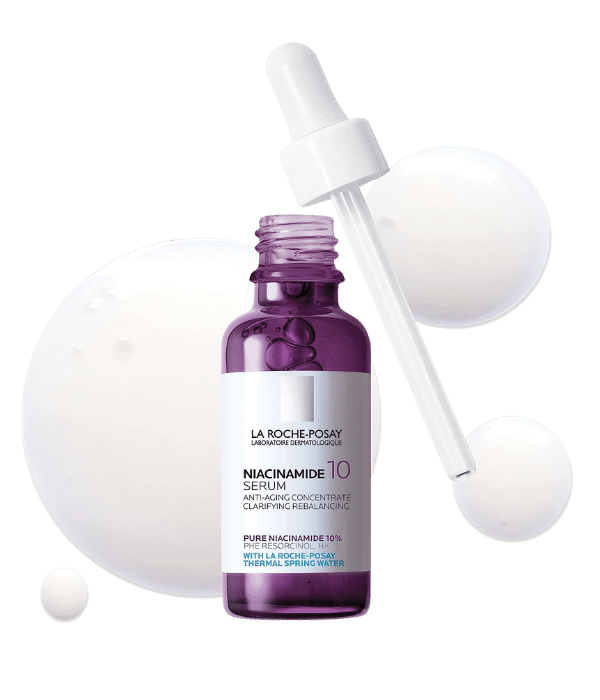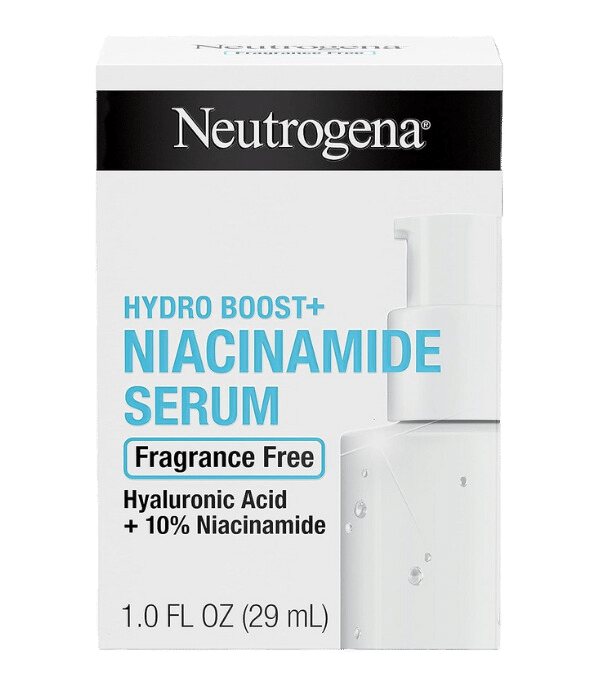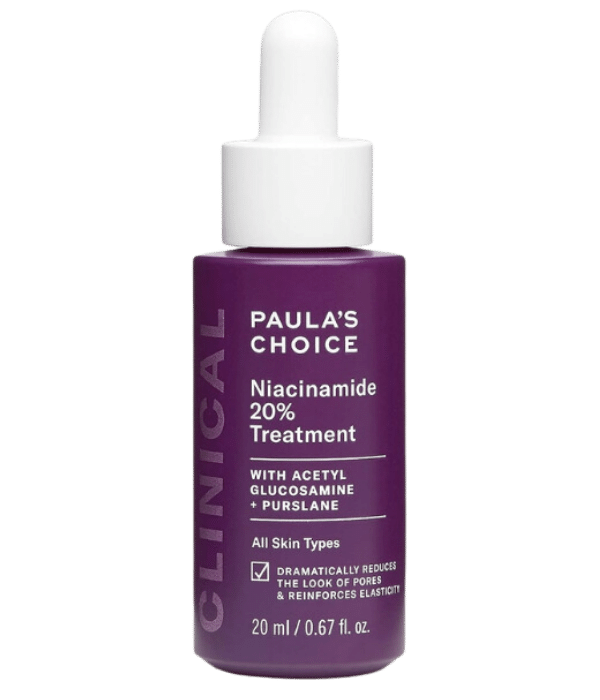Try our favorite, clean protein powder: See our top pick →
Try our favorite, clean protein powder: See our top pick →
This post contains links through which we may earn a small commission should you make a purchase from a brand. This in no way affects our ability to objectively critique the products and brands we review.
Evidence Based Research To fulfill our commitment to bringing our audience accurate and insightful content, our expert writers and medical reviewers rely on carefully curated research.
Read Our Editorial Policy
Niacinamide, a derivative of vitamin B3, is best known in skincare for its ability to brighten skin, fade dark spots or hyperpigmentation, and smooth uneven skin tone.
However, not all niacinamide serums are alike—some are best for sensitive skin, while higher strengths are needed for oily skin.
In this article, check out our list of the six best niacinamide serums to add to your skincare routine, including our top pick, La Roche Posay Niacinamide 10 Face Serum.
Plus, we’ve got the top drugstore and high-strength options and the best niacinamide serum you can get to target your specific skin care concerns.
Best Overall | Drugstore | High-Strength | |
|---|---|---|---|
| Product | La Roche Posay | Neutrogena | Paula’s Choice |
| Concentration | 10% | 10% | 20% |
| Cost | $39.99 for 1oz($39.99/oz) Shop Now | $15.76 for 1oz($15.76/oz) Shop Now | $52 for 0.67oz($77.61/oz) Shop Now |
Best for: Anyone looking for a high-quality niacinamide serum to fight dark spots and skin discoloration.
Our top pick for the best niacinamide serum is La Roche Posay Niacinamide 10 Face Serum, as it contains a trio of ingredients to fade skin discoloration, reduce fine lines and wrinkles, and increase skin moisture—niacinamide, phenyl ethyl resorcinol (a skin-brightening synthetic antioxidant), and hydrating hyaluronic acid.
Niacinamide is also an antioxidant, which protects the skin from future damage, and the French thermal water from the La Roche-Posay region is rich in minerals (especially selenium) and trace elements.
This La Roche Posay serum uses 10% niacinamide, a potent concentration that targets uneven skin texture, dark spots, sun spots, and post-inflammatory hyperpigmentation (brown-colored post-acne discoloration).
However, 10% niacinamide may be too high for people with sensitive skin—and the fragrance may also be irritating for some.
Best for: People on a budget or those looking for a drugstore niacinamide serum.
Neutrogena Hydro Boost + Niacinamide Serum pairs 10% niacinamide with glycerin (a skin conditioner that boosts moisture) and hyaluronic acid.
Hyaluronic acid is a commonly used ingredient in skincare, as it is a hydrating compound naturally found in skin that binds to water, trapping it in the skin’s surface for more supple and plump skin.
With these ingredients, Neutrogena Hydro Boost + Niacinamide Serum targets dark spots and uneven skin texture—and it’s affordable and easy to find at drugstores or big box stores.
However, while it is fragrance-free, the 10% concentration of niacinamide may be too high for some with sensitive skin.
Best for: People with oily, acne-prone, normal, or combination skin looking for the highest strength niacinamide to target large pores and improve skin texture.
For anyone looking to reduce pore size or unclog pores, the high doses of niacinamide in Paula’s Choice Clinical 20% Niacinamide are your best bet.
Although it’s expensive and comes in a small container, Paula’s Choice contains several ingredients to brighten skin, reduce pore size, and smooth skin tone—high-dose niacinamide (20%), purslane extract, vitamin C, licorice root, and acetyl glucosamine.
These clinical-grade doses target advanced signs of aging, and the antioxidants help to prevent future sun damage or discoloration.
However, this serum is best for people with oily, acne-prone, normal, or combination skin, as the 20% niacinamide will likely be too high for those with dry or sensitive skin.
Best for: People with dry skin or sensitive skin looking for a high-quality and affordable niacinamide serum.
For people with sensitive skin, InstaNatural Niacinamide Serum is an excellent choice, as it also contains hydrating and soothing vitamin E, olive oil, and avocado oil.
You’ll also find antioxidants, vitamin C, and natural scents courtesy of the botanical blend of rosemary extract, hibiscus, lavender, and meadowfoam.
Niacinamide and vitamin C are both incredible skin-supporting ingredients, as they can work synergistically to brighten skin and smooth out uneven skin texture.
However, one downside is that this InstaNatural serum does not state what percentage the niacinamide is.
Best for: People with mature skin, acne-prone skin, or those looking to prevent signs of aging with niacinamide.
TruSkin Vitamin C-Plus Super Serum is the best niacinamide serum for anti-aging, as it combines niacinamide, botanical-based hyaluronic acid, rosehip oil, vitamin C, and retinol—five powerhouse ingredients for fighting fine lines, wrinkles, sun spots, and skin dehydration.
Retinol is well-known for its anti-aging qualities, as it increases skin cell turnover, treats hyperpigmentation, and unclogs pores to clear acne—however, retinol is often too harsh for sensitive people, and it increases sensitivity to the sun.
This TruSkin serum also contains natural sources of acne-fighting salicylic acid, soothing aloe vera, and the anti-inflammatory plant gotu kala.
Best for: People with acne-prone or oily skin; people with acne scars or post-inflammatory hyperpigmentation.
The Ordinary Niacinamide 10% + Zinc 1% Serum is our top choice for people with oily or acne-prone skin, as it combines 10% niacinamide with 1% zinc to reduce excess oil production and further clarify skin.
Zinc is great for fighting new breakouts, as well as healing old acne scars and post-inflammatory hyperpigmentation, while niacinamide brightens and smoothes skin.
This serum is lightweight, does not leave a residue, and is non-irritating and hydrating, as it supports the skin barrier.
They also have a clinical study to back up the results—35 people who used it twice per day had more hydrated skin after 7 days and smoother skin after 8 weeks.
Niacinamide, a derivative of vitamin B3, is best known in skincare for its ability to brighten skin, fade dark/sun spots or hyperpigmentation, and smooth uneven skin tone.
It works by interfering with the transfer of melanin pigment in the skin, meaning that any melanin created by sun exposure (included sun spots) or inflammation (like acne) doesn’t rise to the skin’s surface, or is able to be faded more quickly
Niacinamide serum should be put on before a moisturizer, night cream, or face oil, as it is a water-based serum that is lighter than the others.
It depends on your skin type and skin goals.
If you have sensitive, extra-dry, or rosacea-prone skin, you may want to use lower concentrations (5%). If you have oily, acne-prone, normal, mature, or combination skin, 10% niacinamide is a good starting point. If you have extra-large pores, clogged pores, or very oily/acne-prone skin, you can try 20% niacinamide, like Paula’s Choice Clinical 20% Niacinamide.
It used to be said that you shouldn’t combine vitamin C with niacinamide, but that advice appears to be a myth.
Outdated research that combined pure forms of niacinamide with ascorbic acid at very high temperatures led to skin irritation. However, this is not a real-life scenario, so dermatologists now say it is fine to combine niacinamide with vitamin C.
However, one ingredient family to be careful of mixing with niacinamide are AHAs/BHAs (alpha hydroxy acids and beta hydroxy acids), such as mandelic acid and glycolic acid.
While most people are fine combining these, it can sometimes cause excess drying, irritated skin, inflammation, or flushing in others. If you want to use both AHAs/BHAs and niacinamide, try a spot treatment of a small amount of niacinamide first, followed by the acid 30 minutes later, and see if any irritation occurs.
Too much niacinamide generally doesn’t cause an issue. If you have sensitive skin, you may see some itching, redness, or irritation. However, you’re more likely to run into these issues if you use a higher percentage of niacinamide, rather than too much of a low-to-moderate concentration.
Subscribe now and never miss anything about the topics important to you and your health.